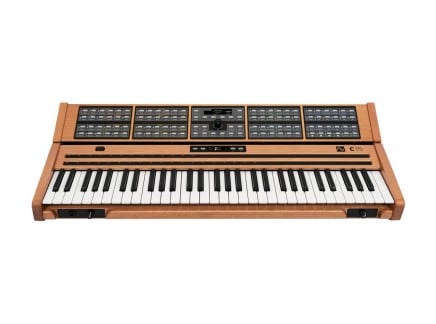There are a lot of expensive synthesizers out there. Sometimes they feel worth it, and sometimes...they don't.
Working at Perfect Circuit, I've had the good fortune to play a lot of synthesizers—analog, digital, hybrid, vintage, new, old classics, obscure oddities. But like many synth enthusiasts out there, I don't have the financial flexibility to buy everything that seems interesting to me...so every time I encounter a new instrument, I try to see it through my own perspective as a potential consumer. I'm not really at risk of buying a new synth every week (or every month...or every year), but working in instrument retail, I'm inclined to think about how an instrument's price:feature ratio might impact how it is received. So when a new instrument comes along, I have to ask a number of questions. Does [this new instrument] offer something distinctly different from other things in its price range? And perhaps more importantly, does [this new instrument] offer such a unique experience that its value seems abundantly obvious? Does it offer something so unique or inspiring that, at its price, it feels like a no-brainer for someone looking for its features?
Though the answer is always subjective, some instruments really feel like they check these boxes immediately. Personally, I think the ASM Hydrasynth is easily worth its price, to the point of being an obvious contender for a huge range of people looking for a new instrument. I think the Make Noise 0-Coast fits the same bill for a different type of musician; I feel the same about Korg's recent ARP 2600 FS, and on the opposite end of the price spectrum, the Volca FM. On the other hand, some instruments are quite polarizing based on their price alone—the Moog One and Waldorf Quantum, for instance, are worth the price for some musicians, but certainly not for all, and don't seem to have been designed with hopes that everybody in the world would want them. Some instruments, though, are polarizing based on their design concepts alone...and when combined with a high sticker price, this can really make me question an instrument's purpose.
If you're familiar with the Nonlinear Labs C15, you're probably aware that it falls into this camp. It has a relatively high sticker price, a somewhat odd synthesis structure, and is in many ways based on a seemingly intentional defiance of synth design concepts that many musicians consider crucial (more on that in a bit). When I started thinking about doing a demo video and review with the C15, I was skeptical—I wasn't sure how I was going to feel about the instrument after getting my hands on it, or if (as a non-keyboardist) I would be able to get it to do anything sufficiently interesting. (Spoiler alert...I had a great time getting to know this instrument.)
So for those of you who aren't familiar with the C15, let's dive a bit into what it is, and unearth a little bit about why it's so polarizing. I'll pepper in my own opinions throughout—and hopefully in doing so will unearth some clarity about how it works and what its designers were thinking.
Nonlinear Labs / C15 History
 Stephan Schmitt, founder of Nonlinear Labs
Stephan Schmitt, founder of Nonlinear Labs
Understanding the C15 partly requires understanding the story behind Nonlinear Labs itself. Nonlinear Labs was founded in 2011 by Stephan Schmitt. If his name sounds familiar, there's quite a good reason—Schmitt has had his hands in some overwhelmingly popular products. Beginning his work in synthesis development in the early/mid-1990s, his initial work led to the foundation of one of the most popular virtual instrument companies to date: Native Instruments. In fact, in a time when most DSP-related software required dedicated hardware to execute its tasks, Stephan had a revelation that well-designed code could run on a PC's native hardware, instantly transforming an office tool into a musical instrument...hence the name Native Instruments. In many ways, Stephan and his colleagues were pioneering the concept of the computer as a musical instrument...which in many ways today feels like a given.
Some of Schmitt's early concepts, such as the idea that good software in general should have a modular nature, eventually grew into completely game-changing ideas. This ideal of software modularity developed into Generator, and eventually into Reaktor—a modular software platform that is still ubiquitous. To Schmitt, Reaktor became a way of allowing people to constantly build and re-build their own personal instruments with an enormous degree of flexibility. This inherent flexibility and freedom combined with the social evolution of the Internet in a way where groups of physically displaced Reaktor users could share their patches and discoveries with one another...in many ways solidifying its role as an essential tool for many experimental synthesists and forward-thinking sound designers.
While software instruments today can be taken for granted, it's remarkable to remember that a mere 25 years ago, such things did not exist. Sure, there were digital instruments with dedicated, specialized internal computers—but turning general-purpose home computers into a new form of musical instrument was a radical a new reality in the 1990s...one that people had been working toward for some time, and first realized by companies like Native Instruments.
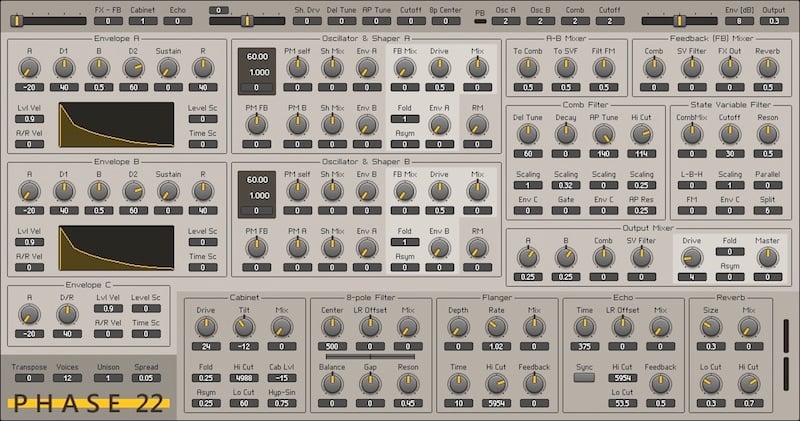 Phase 22, one of Schmitt's Reaktor creations that would evolve into the C15
Phase 22, one of Schmitt's Reaktor creations that would evolve into the C15
Stephan continued to develop Reaktor-based instruments as the president of NI, creating popular instruments such as Spark, Prism, Skanner, and Kontour. Without diving too deeply into any of these instruments, it's safe to say that they represent an evolution in Schmitt's thinking about synthesis...leading ultimately to a synthesis structure he refers to as Phase 22. We'll discuss Phase 22 in greater depth later, but suffice to say for now that it is not your average synth—it harnesses concepts from FM to wave shaping, physical modeling, and an extensive use of feedback in order to create uncommonly dynamic and pleasantly chaotic sonic structures: sounds that respond organically to performance information like velocity, pressure, and more, and whose parameters are almost all continuously variable. There are no hard switches for wave shape or filter modes; instead, everything in Phase 22 is about smooth transitions and high-resolution continuous variability in sound.
Eventually, Schmitt moved on from Native Instruments in order to focus on his other business venture...Nonlinear Labs, whose sole product is the C15 keyboard. And the C15 is very much a direct evolution of Phase 22 and Kontour in dedicated physical form. The C15 is no doubt capable of an enormous array of sounds from realistic percussion and strings to FM-like timbres and lush polysynth tones...but the controversy about the C15 isn't so much about how it sounds, but more about how it can be played.
C15 Build Quality + Design Philosophy
So let's get some obvious points out of the way. The C15 is a beautifully-made instrument. It is made of a combination of aluminum, steel, and wood—and its weight definitely reflects this. It feels sturdy, reliable, and looks, to me, absolutely beautiful. Where some synths are clearly the product of large-scale manufacturing, the C15 evokes the craftsmanship of instruments of the past—spinets, clavichords, or even a Synclavier. Its keyboard feels wonderful, it features two full-length ribbon controllers, and a super-sensitive bender not unlike those found on a Nord...but somehow it feels much nicer, and a bit less resistant? In any case, the C15 was designed with a very specific visual aesthetic, and it is built out of obviously high-quality components and feels like it's going to last.
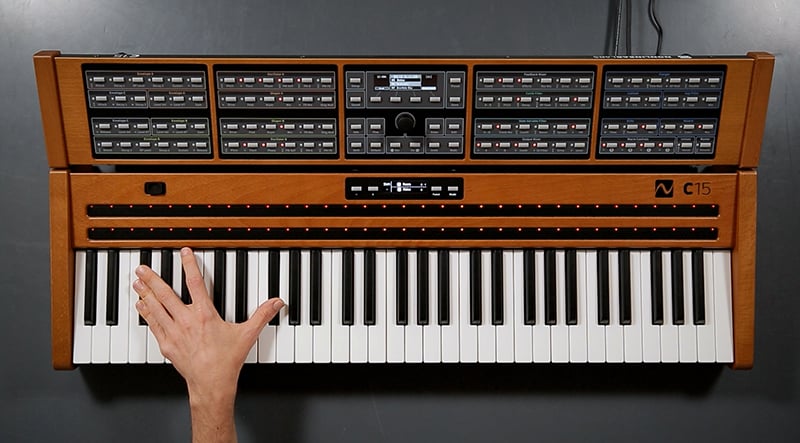
According to Schmitt, the C15 is made to be played...and in many ways, this is the core of its most polarizing aspect: a complete lack of support for MIDI. This may seem like a shock to some; after all, how can you have an electronic instrument worth over $4000 that doesn't have MIDI? Well, they've done it—and in doing so, might seem to have narrowed the niche of musicians who might find the C15 to be a useful instrument. That's probably true, to an extent. After all, many musicians today rely on using a computer as a central hub of control for their entire studio, and need to be able to keep their whole setup running together in time without having to get their hands directly involved in the instruments that they are controlling. So if that is critically true of your workflow—sorry, the C15 probably isn't for you. In fact, the C15 doesn't even really have any form of internal automation. No sequencers, arpeggiators, or even LFOs.
I'll admit, as an amateur-at-best keyboardist, this was the thing that made me most concerned about the C15. It has an esoteric sound engine and intentionally excludes features that a huge number of electronic musicians expect in any instrument. This combined with the C15's price, to me, at first came across with an air of pretense and elitism. For me, one of the most wonderful things about electronic instruments in general is that many allow the user a huge amount of flexibility in determining how their interactions manifest in terms of sound—that is to say, a key part of developing your "voice" on an electronic instrument is about determining what all happens between your physical input information and the sound that it produces. With a lack of internal modulation and MIDI, it seemed to me at first that the C15 was leaving out some of the best parts of making electronic music.
However, after some thought, I realized that was really just a personal value, and there's not really a rule out there that says every synthesizer needs to conform to the values of every synthesist. I think it's probably safe to say that trumpeters seldom get jealous of a violinist's strings, and pianists probably aren't significantly bothered by a saxophone's relative portability. I think that I personally am just used to thinking that, as a synthesist, I should be able to approach any synthesizer and make it fit into my music...which, when compared to other types of instruments, seems a little bit absurd. And while incredible musicians like Roscoe Mitchell or Anthony Braxton seem to be able to pick up any given instrument in their "family" and play the heck out of it, that is definitely the exception, and not the rule.
So Do You Really NEED MIDI or LFOs?
All that said, after getting my hands on the C15, despite my lack of real keyboard chops, it started to feel clear why so many of Schmitt's decisions were made. Let's talk about the "lack" of modulation sources. Sure there aren't any dedicated LFOs, no sequencer, no random modulation generators, no modulation matrix. However, there are quite sophisticated multi-breakpoint envelope generators, and the audio oscillators can breach into subsonic territory and in some cases can act as modulation sources. As for modulation routing, it feels like virtually every sensible internal mapping is pre-mapped: envelopes are assignable to virtually every sensible parameter, and the oscillators are equipped to modulate basically every sensible parameter...even in combination. What's more, an enormous number of parameters can be modulated through the instrument's various user interface elements.
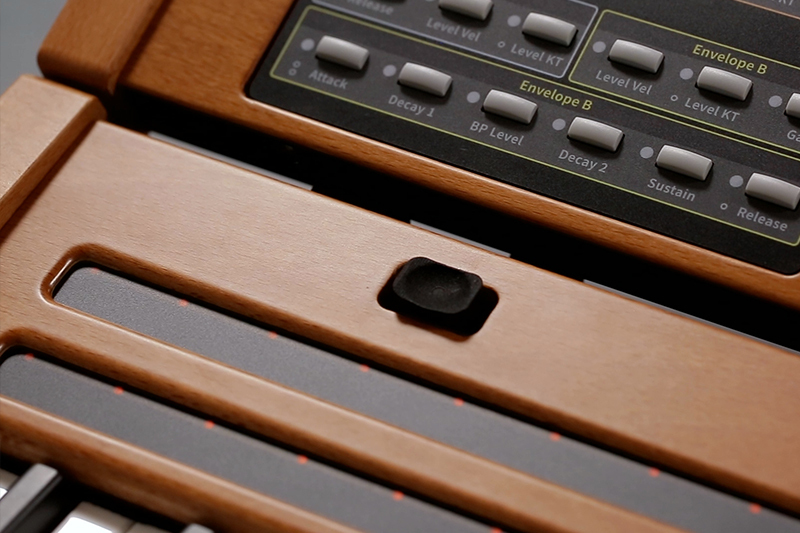 Performance controls on the Nonlinear Labs C15
Performance controls on the Nonlinear Labs C15
For instance, key velocity can be used to vary the intensity and duration of the envelopes—and because of the high-end keybed and remarkably high internal data resolution, the velocity sensitivity feels real in a way that can be difficult to approach with other instruments. In the best scenarios, it can start to feel like you're interacting with an acoustic instrument. The response honestly feels good enough that I found myself playing things I typically wouldn't believe that I could...something about the feeling itself was inspiring, and seemed like it was guiding how I was playing. That...is a good thing, and as I've learned over the years playing synthesizers, a rare thing. It's all too common to get your hands on a highly-revered instrument and be disappointed the moment you feel the relationship between the keypress and the sound. That doesn't happen with the C15.
As for the other performance data control sources—aftertouch, bender, ribbons, and the four expression pedal inputs—these can be assigned to any internal parameter using the C15's Macro functionality. In fact, multiple control sources can even be assigned to a single macro, and a single macro can be assigned to dozens of internal destinations at once, making it possible for the lightest touch of the pitch bender to have huge, sweeping effect on the instrument's overall sound. So sure, there's no internal sequencer...but it's surprisingly easy to use a single controller to really warp the behavior of the sound. And when that control source can be something as simple as key pressure or moving your finger across a ribbon, it becomes very straightforward to get to nuanced, expressive results that, to be honest, are downright hard to program from a MIDI sequencer.
Of course, one of the biggest catches with MIDI is that, for 2020, it has remarkably low resolution. In MIDI, most continuously variable parameters have, of course, only 128 potential steps of resolution. And while this is sufficient for many synthesizers, it truly does feel like this low-resolution control would counteract some of the rather nice things about the C15. Much of the C15's internal signal path is based on feedback and subtle time delays—and being able to program this or vary these in minute amounts is often hugely valuable. If you divided each parameter's total range into 128 steps, you'd be missing universes of sounds in between these steps—so for this technical reason, I can understand Nonlinear Labs wanting to dissuade people from using MIDI to automate parameters. Schmitt has indicated in interviews that he might consider offering a MIDI 2.0 implementation in the future (given MIDI 2.0's support for much higher data resolutions)...but since the exclusion of MIDI also seems so intrinsically tied to his ideas about how people should interact with the instrument, perhaps we shouldn't hold our breath. It's not like we're drowning in MIDI 2.0 control sources yet, so probably best not to count on that as a feature in the immediate future.
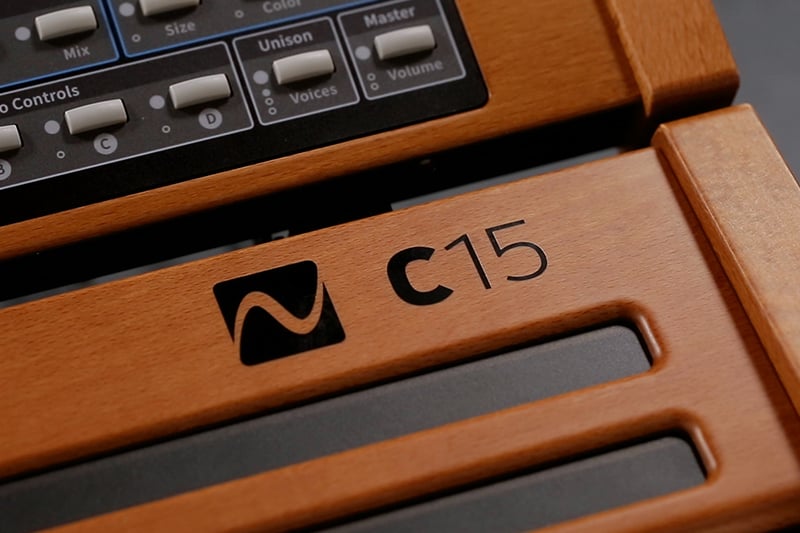
So, before moving forward to talk about the sound engine, let's bluntly address some facts about the C15. It's fairly expensive, it is heavy, it is very well-made, it is not organized internally like nearly any other synth, and it doesn't have MIDI support. It is a niche instrument, and it's just not for everyone. It won't sync to your DAW if you don't have a good internal metronome, and if you want to play this synth, you've got to get your hands on some black and white keys—so if you're opposed to that, this is probably not for you. That said, I was happy to find that having a black and white keyboard definitely doesn't mean that you need to be a keyboard virtuoso to get a lot out of it. In fact, I think that if you're the type of musician who values unique sounds and enjoys tactile control, you would enjoy playing this instrument. Given how responsive and flexible the sound engine is, even playing a single note with varied dynamics or letting sounds evolve over time can be remarkable. So in the end, I'm happy to meet this instrument in the middle and accept it for what it is. Despite initially feeling put off by the obvious lack of what seemed like critical features, once I started getting into the various sound design aspects, I found it a pleasure to play.
Phase 22 Overview
Users of Native Instruments Kontour will be immediately familiar with the C15's inner workings: it's based on an almost identical signal path. Schmitt himself attests that the synth engine is the result of years of continuous development, and contains concepts explored in many of his other virtual instruments as well, including the popular CHA-OSC, Spark, and Prism.
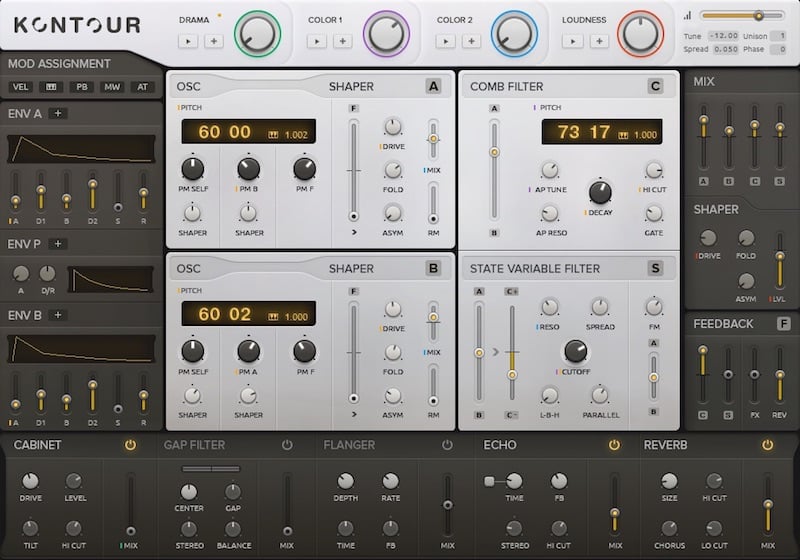
So what's actually in Phase 22? The core elements for each voice include two oscillators, each with their own wave shaping processors, a ring modulator, a comb filter, and a state-variable filter, as well as three envelopes—two which are hard-wired to the loudness of each of the oscillators, and one which is more freely assignable. At the end of the signal chain, there is a global cabinet simulator, gap filter, flanger, echo, and reverb (in series), adding a sense of body and space to the sound.
But what is most important here is that the signal path between all of these things is remarkably knotted. Phase 22 features multiple ways to create feedback both on local and global scales and everywhere in between, which can result in everything from subtle nonlinearities to intense, abrasive explosions of sound. It is in this embrace of feedback that the C15 really comes to life: after all, permitting time delays and allowing a system's output to influence its own input is a great way of generating complex and lively sonic results (ever plug an oscillator into a delay, and then use the delay's output to modulate the oscillator's frequency? Give it a shot). The C15 is all about starting with a few simple sonic resources and creating webs of feedback and subtle (or not-so-subtle) interactions between multiple elements. And by using key velocity, or pressure, or a bender to slightly alter the overall signal routing, you can create disruptions in the structure that feel like they have actual physical resistance, the way that violinists varying their bow pressure can create an astonishing range of tones from airy whispers to singing-like tones to guttural groaning and the sounds of splintering wood.
As stated before, there aren't simple "on/off" or switch-based parameters (like on other synths, where you might select which oscillator wave shapes are active, or which filters are in use, etc)...every control is completely continuous, allowing for careful and precise balancing of the audio and control signal paths. And since every parameter is available for continuous macro control (and many available for modulation via key velocity or the internal envelopes), it becomes possible to seamlessly morph between tones. In fact, the preset system even allows you to define an interpolation time between presets—so when you switch to a new sound, it can gradually change from one preset to the next. And because the sound engine is so highly variable, this means that you can continuously morph from, say, a DX7-like electric piano to a completely amorphous, bubbling soundscape.

Once you've wrapped your head around the overall signal flow (pictured above), it's pretty easy to start planning out sounds and interactions. And truthfully, it's fairly easy to edit sounds on the C15, though I expect the hardware user interface might not be everyone's cup of tea. The C15 is a two-piece instrument: it features a base unit and panel unit which can be disconnected from one another entirely. The base unit contains the keybed, realtime controllers, and all I/O as well as the instrument's sonic brains, whereas the panel unit offers a simple display, a large array of buttons, and a single encoder for editing all parameters. While the panel unit does provide rapid access to every internal parameter, my only real complaint is that the sound engine's complexity and overall signal routing is not really obviously revealed by the panel layout. So until you sit down with the signal flow diagram and take the time to cross-reference between it and the panel unit, it's not very obvious how things are laid out. This goes away with time and after a couple of hours you'll have no difficulty navigating the synth. Could this be avoided? I honestly don't think so, at least not without a much more complex interface and a much higher price. Best of all, since the UI relies on a grid of buttons with replaceable magnetic foil panels, future firmware updates can be visually manifest fairly easily—in fact, there are already plans to produce new panel foils so that users can swap theirs to reflect features added in recent firmware.
 The C15's virtual user interface
The C15's virtual user interface
Of course, if the lots-of-buttons-and-one-encoder UI isn't for you, the C15 offers the pretty ingenious option of editing via Wi-Fi. In fact, the C15 hosts its own simple Wi-Fi network—so any Wi-Fi enabled device with a browser can connect and edit with a quite easy-to-navigate virtual user interface. You can zoom in to any section you're trying to edit with remarkable resolution, and can even use the virtual UI to manage presets...and in many ways, this virtual UI is much more immediately understandable than the physical UI. However, I personally didn't bother with the virtual UI and found after a short amount of time that I was perfectly fine with doing all the work from the panel unit.
So let's take a closer look at some of the individual sections of the C15's signal structure to think through how you might go about generating some interesting sounds. Of course, an exhaustive explanation of the sound engine is too much to get into here, but we can touch on some of the basic concepts.
Oscillators + Shapers
The originating generator for all sounds is the oscillator section. The C15 has two sine wave oscillators with their own dedicated virtual amplifiers...each acting something like a typical FM operator. And in fact, they are capable of DX7-style phase modulation, providing a huge range of timbres from even one oscillator alone. The oscillators can be phase modulated by one another (even at the same time for gnarly cross modulation), by their own output (yielding everything from simple sines to rich, organic, saw-like tones), or through various other sources of feedback from further downstream. So while seeing that these are technically just sine wave oscillators might seem like a deterrent, don't let it be—they can do everything from the cleanest sines to outright cross-modulated chaotic nonsense easily. There's a filter in the phase modulation feedback path to help tame some of the screechier tones, though of course, sometimes screeches are what you need.
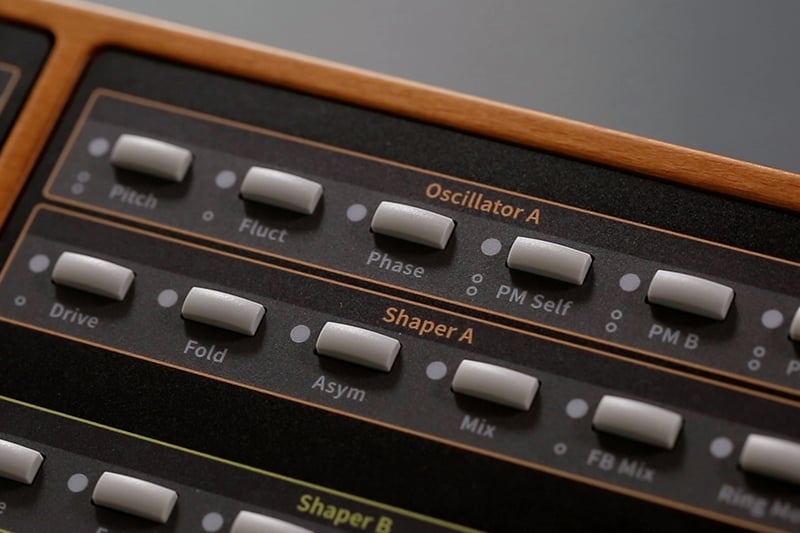
The downstream processes (filtering, effects, etc.) can be fed from the oscillator outputs themselves (via the oscillators' dedicated amplifiers, allowing dynamic signals to be sent into these processes), or can first pass through the oscillators' dedicated Shapers. Shapers are important in the C15—they're present at many output stages (including the feedback mixer and final output mixer), and allow for dramatic tone shaping. Those familiar with so-called "West Coast" synthesis techniques will no doubt find the Shapers of interest: they are effectively distortion/wave folding effects that allow you to dynamically add harmonics to incoming signals. With controls for drive, fold amount, and asymmetry, it's possible to create almost Buchla-like snarling timbres. Interestingly, the oscillators' shapers also allow for injection of feedback from downstream processes, making them a great point for introducing nonlinearity into the signal. Feedback through a wave shaper can be...intense.
Nonlinear Labs refers to the structures that include the oscillators/shapers as "branches," labeled A and B respectively. This is because the signals that pass out of the shapers are not necessarily strictly derived from the oscillators alone...and in fact, these signals can be influenced via feedback from sections later in the synthesis path.
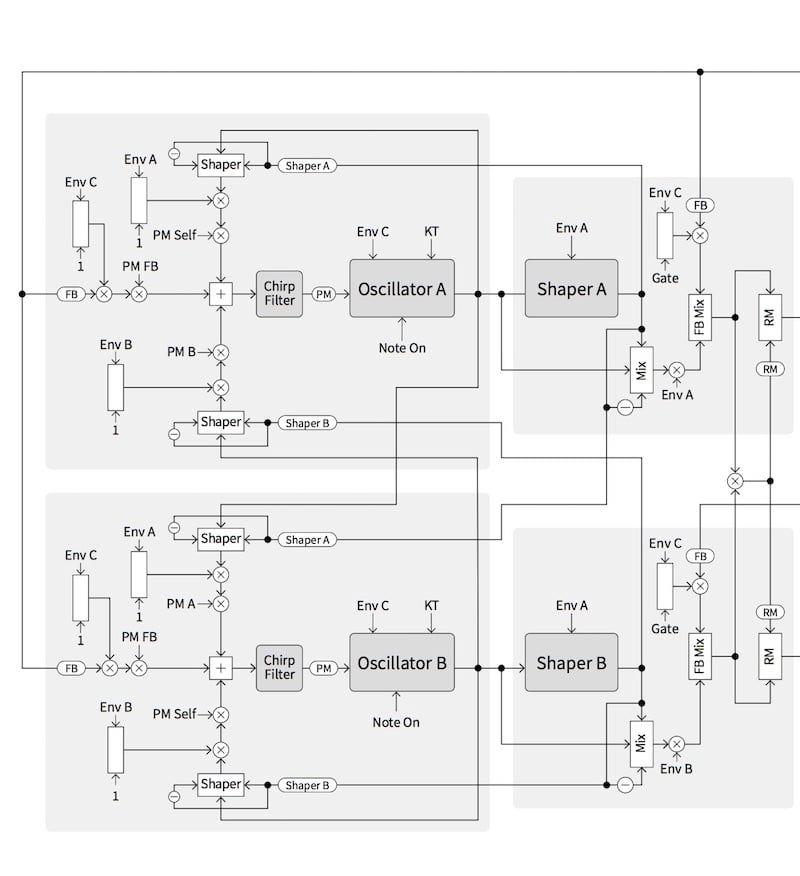
It's worth noting—the oscillators' tuning is measured in semitones (according to MIDI note numbers). This make it very easy to dial in precise tuning ratios between oscillators for more "classic FM" kind of sounds. However, the oscillators' frequencies can indeed go into the sub-audio range, and can be utilized as modulation sources for one another and for the filters. So the blanket statement that the C15 doesn't have LFOs is actually somewhat untrue, though these are by no means conventional LFOs. Additionally, the oscillators can be ring modulated, allowing for everything from tremolo to classic RM effects. Also, you can continuously alter the oscillators' key tracking—so it's easy to create a wide range of detuning-based effects, or to create fixed-frequency modulation rates for other processes.
The other point that's fairly easy to breeze past that is critically important is that these oscillators are dynamically controllable at the level of the oscillator itself. Envelopes A and B are intrinsically tied to the output level of oscillators A and B before any other processes in the signal chain. So this isn't like a typical synth where key velocity and envelopes control a sound's level post-filter—the dynamic control happens before the filters, allowing the oscillators to act more like exciters and the filters more like resonators (more on that in a moment). And because the envelope intensities and durations can be dynamically controlled from the keyboard, it becomes very easy for your key articulation to determine the shape of an entire note, and to do so with a surprisingly organic feeling. Releasing a key doesn't exactly "choke" a note in many scenarios...instead, it just causes the sound's exciter to stop, and allows the sound's resonance and body to continue.
The Output Mixer and State Variable Filter
After the oscillators, the sound can take a number of paths. The Output Mixer section can be used to send any of the main sound production/processing elements directly to the effect section: so you can send branch A or B's outputs straight along, in parallel with the filters in any proportion. Sending the oscillators straight to the output and foregoing the filters altogether is completely possible, and still offers a huge wealth of sounds—given the dynamic and timbral range of the oscillators themselves, you don't even necessarily need to touch the filters to get huge, awesome sounds happening. Of course, the filters themselves have a lot to offer.
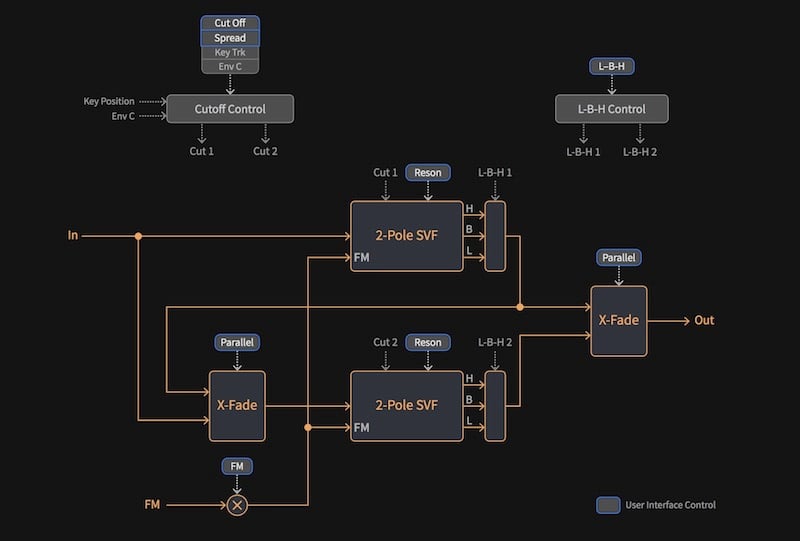 The C15 SVF's internal architecture
The C15 SVF's internal architecture
Let's talk about the State Variable Filter first. The SVF is, as its name implies, a more "classic" synth filter, capable of morphing continuously between lowpass and highpass responses. The SVF can be fed directly from the oscillator section, and features a crossfader for continuously varying the proportional balance of these oscillators going into its input. It features classic cutoff and resonance controls, as well as an option for filter FM—which provides a similar crossfader for allowing influence from either the A and B branches, or a mix of the two. This becomes super interesting territory for sound manipulation. For instance, by tuning one oscillator to sub-audible frequencies and assigning it as the sole filter FM source, you have classic LFO-style filter modulation. If you then use, for example, aftertouch to vary the oscillator frequency, you have dynamically controllable LFO speeds. And since you have the ability to alter the key tracking of the oscillators, you could make it such that the LFO speed remains constant regardless the played pitch, effectively decoupling the oscillator frequency from the keyboard.
Because you can really make such a huge range of more or less traditional synth tones via phase modulation, the filter really opens the potential for some classic synth sounds...so if you've heard demos that focus on more FM-like tones, physical modeling, or pseudo-electric piano, don't worry...there's plenty of "synth" stuff available in here as well. Interestingly, the filter, like the oscillators, is tuned according to MIDI note numbers and not frequency. So, when doing audio-rate filter FM (which has a just insane, ripping sound to it), it's easy to dial in very specific, clean FM ratios—just like with the oscillators. And, as with the oscillators, you can continuously vary the key tracking.
The Comb Filter
And then there's the Comb Filter. For all your Waldorf Q or classic VA fans out there, you might be thinking that comb filters are sort of a novelty, and that it's hard to make them do much more than phaser/flanger-like modulation effects. And if that's your perspective, it might seem odd that the Comb Filter is, along with the oscillators and SVF, one of the most important central components of the C15's sound structure. Spending a couple of moments with it, though, you quickly realize that this section has a tremendous amount of depth, and is the key way in which the C15 can breach into the realm of physical modeling. The comb filter here, in fact, is something more like a resonator, allowing for everything from the glassy rings and muted slaps of modal synthesis to the twangy, edgy zing of Karplus-Strong techniques.
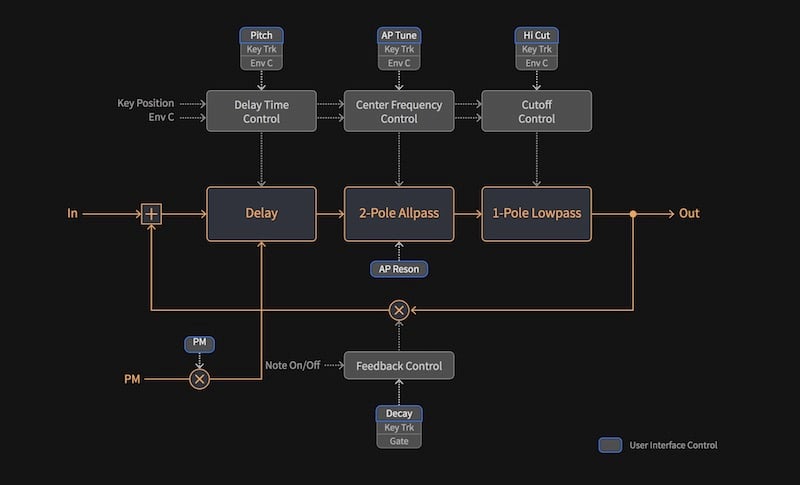
Like the SVF, the Comb Filter can be fed from either branch in combination using a crossfader-like input control. It additionally features controls for Pitch, Decay, Allpass Tune, and Hi Cut, which respectively alter the rate of a delay line, amount of feedback, tuning of an allpass filter (with a secondary control for resonance), and tuning of a gentle one-pole lowpass filter. These are some of the basic ingredients of physical modeling in general. Using these parameters in the right combination, you can dial in an enormous range of responses: in fact, it can sound like a phaser or flanger when swept, but for me, the real magic of this section lies in finely tuning relationship between all of these parameters. These high-level adjustments allow you to dial in sounds similar to fixed filterbanks, vocoders, or swarms of bandpass filters all moving at once. The best aspects, though, lie in finding a good balance between the behavior of the comb filter and the oscillators/branches that precede them.
If you dial things in just right, the Comb Filter really can act like a modal resonator or Karplus-Strong-like string. If you dial in a high decay value and experiment with different pitch and AP Tune values, you'll find that the Comb Filter leaves a ringing tone after each key release—and in this situation, the oscillators become more like an exciter than a sound source per se, and the Comb Filter itself becomes the point of aural interest. In fact, by doing intense cross-modulation and self-modulation at the level of the oscillators themselves, you can sculpt exciter signals that range from quick, plucky clicks to smooth, continuous noise, or all the way into chaotic, sputtery, low-frequency signals. By dynamically controlling the oscillators' envelope shapes as well, your physical articulations can play a huge role in shaping the behavior of the exciter signal. For me, this is where playing the C15 can become particularly uncanny—just by varying your strike velocity, you can go from convincing bowed sounds to brushed drums and intermittent windchimes. Something about hearing these remarkably clear and realistic tones morph between one another in response to physical touch is almost chilling...and of course, using articulation to vary envelope intensities or key pressure to vary tuning/dampening gives a startling life to these sounds in a way that I've never experienced in a dedicated instrument (on a not-so-unrelated note, I've spent a good amount of time with Waldorf's Quantum...). You can also do phase modulation from the oscillators to the comb filter, which results in everything from FM-like behavior to bubbling, churning drips and resonances.
The comb filter can proceed directly to the effects via the output mixer or can be used as a source in the SVF. Additionally, both filters are available independently in the Feedback Mixer, which allows these processors to influence earlier parts of the signal path as well. Now, be aware that this can get out of hand super quickly—it has the potential to strongly reinforce the (various) resonant frequencies of the filters, and can lead to chaotic howls in no time. The feedback mixer even features its own shaper section at its output (complete with drive and wave folding parameters), allowing for intense timbral discontinuities. In small amounts, this can lead to unexpected, organic shimmers and ringing resonances—and in larger amounts, it can result in tortured howls and shrieks. And in fact, it can go from gentle to clean simply by varying your key pressure or other performance controls...and frankly, that kind of range from a simple control source is rare and, I think, quite valuable.
End of Chain Effects
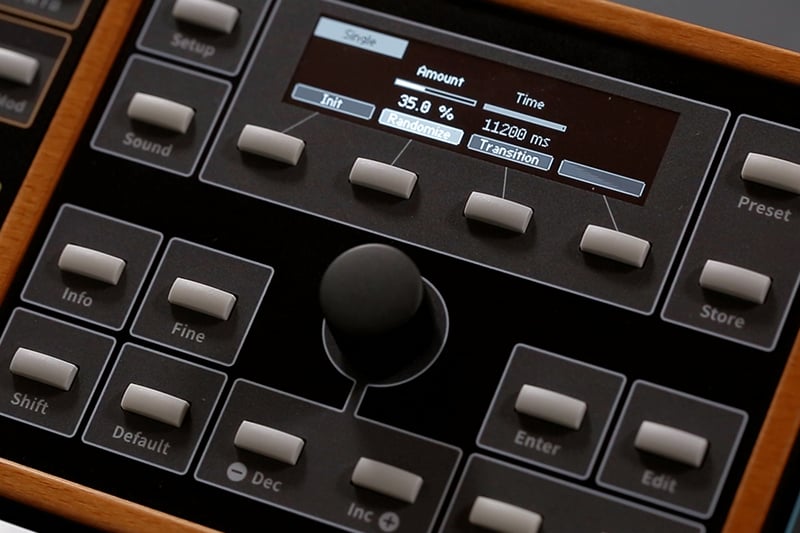 Editing interface detail on the Nonlinear Labs C15
Editing interface detail on the Nonlinear Labs C15
The final step in the signal chain is the effect processing section, which takes the raw voice of the synth and gives it a body and space. The effects section is comprised of a flanger, cabinet simulator, gap filter, echo, and reverb.
The flanger section has a marginally misleading name; while it definitely can produce flanging effects, it's safer to think of it as a general-purpose, short-range time-based effect. It breaches out of the realm of pure flanging and into chorus, with controllable feedback, modulation rate, and intensity. This section combined with some of the synthier oscillator and filter tones can get to almost Juno-like behavior, revealing that the C15, among its million other strong suits, is actually surprisingly good at making nostalgic, 1980s-style synth pads.
The cabinet simulator offers its own drive, tilt-based EQ, and wet/dry mix control. With subtle amounts dialed in, the more physical modeling-esque sounds start to take on a stronger sense of body; but of course, you can also use this section to imitate the behavior of a cranked guitar amp. And since getting to distorted feedback textures is so easy, you can really wrench pretty convincing guitar shreds out of the C15, complete with howling overtones and harmonics. The gap filter allows for further tone shaping via a pair of filters: a 24dB/oct highpass and lowpass filter, respectively, which can be used in series or parallel. This allows for some powerful end-of chain signal shaping—and since it is possible for the C15 to generate some potentially outrageous sonic outbursts, this effect can be as much a safeguard/utility as it is a coloration tool. It allows for the arbitrary creation of everything from typical highpass and lowpass to variable-width bandpass and band reject filter responses, making it a powerful tool at its point in the signal chain.
Then come a stereo echo and reverb—no real surprises here, though their sonic performance definitely stands up along with the rest of the synth, and the inclusion of these effects feels natural. Where the oscillators and filters create the sense of exciters and resonators and the cabinet simulation creates a sense of body, these effects provide a sense of space: in some ways completing the acoustic instrument metaphor. And of course, it wouldn't be the C15 if there weren't feedback: the global feedback mixer allows the introduction of the effect and reverb signals into the early stages of the branches themselves, allowing the creation of high-level feedback loops where a sound's spatial decay can begin to influence its basic timbre. As with some of the other feedback nodes, this can get pretty wild—but by using the echo or reverb sections to alter the earlier parts of the signal path, you can generate sounds that evolve in highly unpredictable, mind-boggling ways.
So Is It Worth It?
There's so much more to say about the C15. The envelopes are novel multi-breakpoint, Attack-Decay-Decay-Release control sources, and are directly accessible in almost every section of the synthesizer. It has several high-level global features we haven't discussed at all: it can be operated in mono/unison modes with definable voice detuning; it now offers keyboard layers and splits (with the ability for overlapping key regions that fade into one another up and down the keyboard); the Macro controls allow for a huge range of customization of the behavior of the built-in and external control sources.
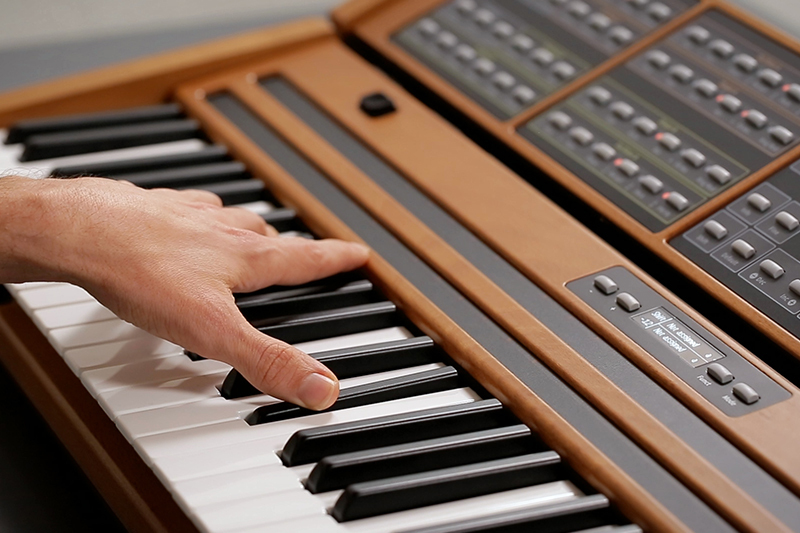 Playing the Nonlinear Labs C15
Playing the Nonlinear Labs C15
In an instrument where each internal section offers such high resolution and such a high degree of nuance, there is no hope that a single text-based review is going to cover the extent of its possibilities. You could spend ages exploring a single oscillator and shaper alone; and when you add another, the possibilities increase exponentially. I'm convinced there's a whole world of potential in the Comb Filter that I've yet to uncover, especially in combination with careful creation of dynamic preceding textures with the oscillators at the "beginning" of the signal path. And in an instrument with so many low-level and high-level opportunities for feedback, nonlinearity is the key: by turning up a single feedback path, the nature of an internal module can change entirely. By dynamically varying the intensity of feedback, the instrument starts to take on an uncanny and sometimes unruly life of its own, and this combined with the physical resistance of the keys, bender, and ribbons makes it feel as if you are interacting with a real, living instruments, and not with a mass-produced keyboard (after all, the C15 is far from mass-produced).
Is the C15 for everyone? No, certainly not—and Nonlinear Labs is content with this. They aren't seeking to make an instrument that fits into every musician's workflow, and truthfully, I've come around to believe that there is no real virtue in creating a truly universal instrument. What they have done, however, is to create an instrument that, to them, embodies a series of beautiful ideas and makes interacting with electronic sound feel real in a startlingly uncommon way. By nature of their design ideals, this has led to the C15 being a fairly expensive instrument when compared to other synthesizers; but honestly, $4000–5000 is not an unreasonable price range for a well-made professional instrument. While this instrument probably won't make it into the hands of countless MIDI-based studios, it probably will make it into the hands of forward thinking jazz keyboardists, film composers, and experimental musicians looking to form a strong relationship with a single instrument.
My opinion by now should be clear. The C15 isn't cheap, but its price is more than justified. They've built an electronic instrument that feels in some inexplicable way like an acoustic instrument, one that gives you back as much as you put into it. You can't necessarily bring traditional "synth" logic to this instrument and expect it to play out like in other gear: it really has its own well-thought-out, idiosyncratic internal logic, from the synth engine itself all the way to the feeling of its keys. The sense of physical resistance, uncanny nonlinearities, and deeply-embedded response to performative gestures collectively have the capacity to create something like its own external creative feedback loop: you play it, it responds, and a conversation begins in which, if you listen closely and try to keep up the pace, can spin out into a discovery of ideas you would never expect to have, or to be able to execute. So if you're looking for a synthesizer or keyboard instrument that you can really form a tactile relationship with, and whose possibilities you will not quickly exhaust, the C15 just might be it.

